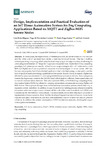Mostrar o rexistro simple do ítem
Design, Implementation and Practical Evaluation of an IoT Home Automation System for Fog Computing Applications Based on MQTT and ZigBee-WiFi Sensor Nodes
| dc.contributor.author | Froiz-Míguez, Iván | |
| dc.contributor.author | Fernández-Caramés, Tiago M. | |
| dc.contributor.author | Fraga-Lamas, Paula | |
| dc.contributor.author | Castedo, Luis | |
| dc.date.accessioned | 2018-10-03T14:56:07Z | |
| dc.date.available | 2018-10-03T14:56:07Z | |
| dc.date.issued | 2018-08-13 | |
| dc.identifier.citation | Froiz-Míguez, I.; Fernández-Caramés, T.M.; Fraga-Lamas, P.; Castedo, L. Design, Implementation and Practical Evaluation of an IoT Home Automation System for Fog Computing Applications Based on MQTT and ZigBee-WiFi Sensor Nodes. Sensors 2018, 18, 2660. | es_ES |
| dc.identifier.issn | 1424-8220 | |
| dc.identifier.issn | 1424-8239 | |
| dc.identifier.uri | http://hdl.handle.net/2183/21104 | |
| dc.description.abstract | [Abstract] In recent years, the improvement of wireless protocols, the development of cloud services and the lower cost of hardware have started a new era for smart homes. One such enabling technologies is fog computing, which extends cloud computing to the edge of a network allowing for developing novel Internet of Things (IoT) applications and services. Under the IoT fog computing paradigm, IoT gateways are usually utilized to exchange messages with IoT nodes and a cloud. WiFi and ZigBee stand out as preferred communication technologies for smart homes. WiFi has become very popular, but it has a limited application due to its high energy consumption and the lack of standard mesh networking capabilities for low-power devices. For such reasons, ZigBee was selected by many manufacturers for developing wireless home automation devices. As a consequence, these technologies may coexist in the 2.4 GHz band, which leads to collisions, lower speed rates and increased communications latencies. This article presents ZiWi, a distributed fog computing Home Automation System (HAS) that allows for carrying out seamless communications among ZigBee and WiFi devices. This approach diverges from traditional home automation systems, which often rely on expensive central controllers. In addition, to ease the platform’s building process, whenever possible, the system makes use of open-source software (all the code of the nodes is available on GitHub) and Commercial Off-The-Shelf (COTS) hardware. The initial results, which were obtained in a number of representative home scenarios, show that the developed fog services respond several times faster than the evaluated cloud services, and that cross-interference has to be taken seriously to prevent collisions. In addition, the current consumption of ZiWi’s nodes was measured, showing the impact of encryption mechanisms. | es_ES |
| dc.description.sponsorship | Xunta de Galicia; ED431C 2016-045 | es_ES |
| dc.description.sponsorship | Xunta de Galicia; ED341D R2016/012 | es_ES |
| dc.description.sponsorship | Xunta de Galicia; ED431G/01 | es_ES |
| dc.description.sponsorship | Agencia Estatal de Investigación de España; TEC2015-69648-REDC | es_ES |
| dc.description.sponsorship | Agencia Estatal de Investigación de España; TEC2016-75067-C4-1-R | es_ES |
| dc.language.iso | eng | es_ES |
| dc.publisher | M D P I AG | es_ES |
| dc.relation.uri | https://doi.org/10.3390/s18082660 | es_ES |
| dc.rights | Atribución 3.0 España | es_ES |
| dc.rights.uri | http://creativecommons.org/licenses/by/3.0/es/ | * |
| dc.subject | IoT | es_ES |
| dc.subject | Home automation | es_ES |
| dc.subject | MQTT | es_ES |
| dc.subject | WSN | es_ES |
| dc.subject | Wireless sensor networks | es_ES |
| dc.subject | ZigBee | es_ES |
| dc.subject | WiFi | es_ES |
| dc.subject | HAS | es_ES |
| dc.subject | Fog computing | es_ES |
| dc.title | Design, Implementation and Practical Evaluation of an IoT Home Automation System for Fog Computing Applications Based on MQTT and ZigBee-WiFi Sensor Nodes | es_ES |
| dc.type | info:eu-repo/semantics/article | es_ES |
| dc.rights.access | info:eu-repo/semantics/openAccess | es_ES |
| UDC.journalTitle | Sensors | es_ES |
| UDC.volume | 18 | es_ES |
| UDC.issue | 8 | es_ES |
| UDC.startPage | 2660 | es_ES |
| dc.identifier.doi | 10.3390/s18082660 |
Ficheiros no ítem
Este ítem aparece na(s) seguinte(s) colección(s)
-
GI-GTEC - Artigos [190]






